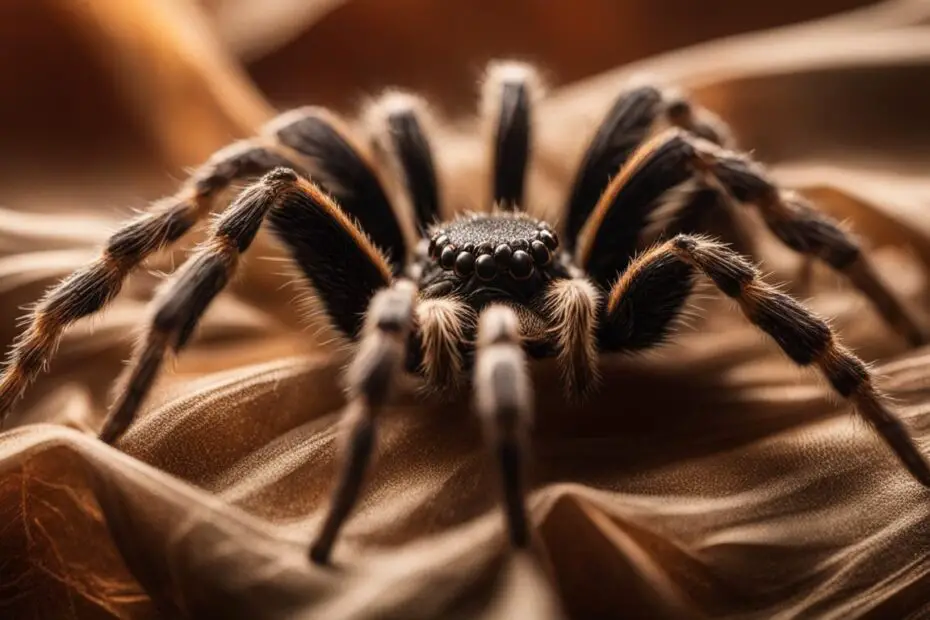Tarantulas, with their fascinating ability to create intricate and captivating webs, have long intrigued both scientists and arachnid enthusiasts. Have you ever wondered how these eight-legged creatures weave their intricate silk masterpieces? Let’s delve into the intriguing world of tarantula web creation and unravel the secrets behind their remarkable craftsmanship.
Key Takeaways:
- Tarantulas use specialized structures called spinnerets to produce different types of silk.
- Web construction involves strategic techniques like spinning, weaving, and architecting.
- Tarantula webs have unique characteristics and designs specific to each species.
- Web formation strategy includes selecting the optimal location and adapting to environmental conditions.
- Tarantula webs play a crucial role in maintaining the balance of ecosystems.
How do Tarantulas Make Webs
The Tarantula Spinnerets: Marvels of Silk Production
Tarantulas, known for their ability to create intricate webs, have a remarkable biological structure called spinnerets. Located at the end of their abdomen, spinnerets are responsible for silk production in tarantulas. These spinnerets, which produce different types of silk, play a crucial role in the formation and construction of tarantula webs. how do tarantulas make webs
Tarantulas have multiple pairs of spinnerets, each specialized in producing a specific type of silk. The silk produced by tarantulas is a complex protein-based material that exhibits exceptional strength and elasticity. It is a fascinating example of nature’s engineering, making it an ideal material for web construction.
“The spinnerets of tarantulas are marvels of silk production. These spiders have evolved a complex system, allowing them to create silk with remarkable properties. The different types of silk produced by tarantulas serve various purposes, from structural support to capturing prey.”
Silk Types and Functions
Tarantulas produce several types of silk using different spinnerets. Major ampullate silk, produced by the major ampullate gland, is the strongest type and forms the structural framework of the web. Minor ampullate silk is produced by the minor ampullate gland and reinforces the radial lines and captures prey. Aciniform silk, produced by the aciniform gland, is used to wrap prey and create a protective covering. Finally, tarantulas have a cribellate gland that produces a wool-like silk used for prey capture.
| Silk Type | Spinneret | Function |
|---|---|---|
| Major Ampullate Silk | Major Ampullate Gland | Structural support |
| Minor Ampullate Silk | Minor Ampullate Gland | Reinforcing radial lines, prey capture |
| Aciniform Silk | Aciniform Gland | Wrapping prey, protection |
| Cribellate Silk | Cribellate Gland | Prey capture |
The spinnerets of tarantulas are a testament to the intricacies of nature’s design. These incredible structures enable tarantulas to produce silk with diverse properties, allowing them to create and maintain their elaborate webs. The study of tarantula spinnerets and silk production continues to provide valuable insights into the fascinating world of spider biology and the remarkable functions of silk. tarantula web creation process
The Tarantula Web Construction Process
Tarantulas are skilled architects when it comes to web construction. Their process involves a combination of spinning, weaving, and intricate techniques to create a functional web. Let’s dive deeper into the fascinating world of tarantula web construction.
Tarantula Web Building Techniques
Tarantulas start by releasing a fine thread of silk into the air, allowing it to catch on a solid structure. This initial thread serves as an anchor for the web construction. Once secured, the tarantula begins producing more silk and forms a framework for the web. They carefully weave radial strands, which radiate from the center of the web, and capture threads, which are sticky silk lines used to trap prey. tarantula web spinning mechanism
The construction process varies between species, but tarantulas are well-known for their intricate and precise web designs. Some species create elaborate, multi-layered webs with zigzag patterns, while others opt for simpler designs with a single layer of silk. These different techniques and designs are influenced by the tarantula’s habitat, hunting strategy, and prey preferences.
Adapting to Environmental Conditions
Tarantulas are adaptable creatures and take into account environmental factors when constructing their webs. They consider wind patterns, humidity levels, and the availability of prey in their chosen location. By adjusting their web building techniques, tarantulas can optimize both prey capture and protection from predators. tarantula silk production
Communication and Maintenance
Tarantulas use vibrations, pheromones, and visual cues to communicate within their web and detect potential prey. The vibrations produced by struggling prey caught in the web alert the tarantula to its presence. Additionally, tarantulas regularly assess and maintain their webs to ensure they remain in optimal condition for trapping prey.
Understanding the intricate process of tarantula web construction enhances our appreciation for these remarkable creatures and the impressive structures they create. The next section will explore the unique characteristics and designs of tarantula webs, shedding light on the diversity and complexity of their silk creations. tarantula web building techniques
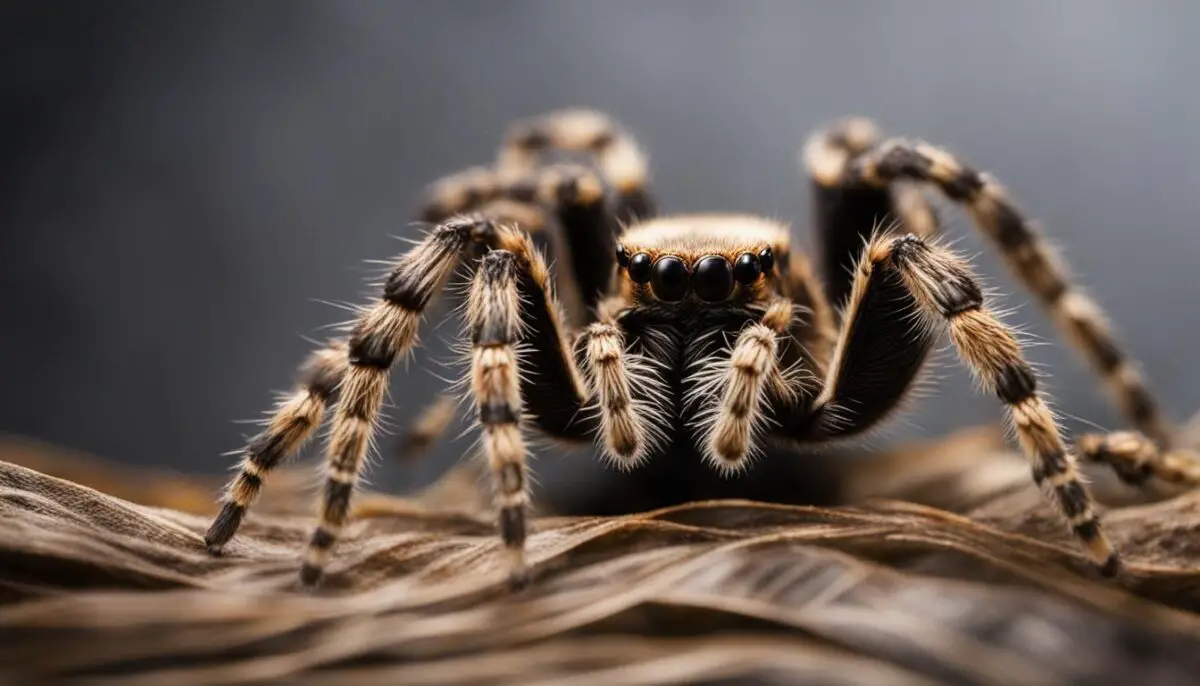
Understanding Tarantula Web Characteristics and Design
Tarantula webs exhibit unique characteristics and designs that are specific to each species. These characteristics and designs are influenced by various factors, including the tarantula’s habitat, hunting strategies, and prey preferences. Some tarantulas construct elaborate webs with multiple layers and intricate zigzag patterns, while others opt for simpler designs with a single layer of silk. tarantula web characteristics
The complexity of the web design also plays a crucial role in maximizing the tarantula’s chances of effectively capturing prey. The arrangement of radial strands and capture threads, which are sticky silk lines that trap potential meals, is strategically defined based on the tarantula’s hunting techniques. These intricate designs and configurations showcase the tarantula’s remarkable ability to adapt and optimize its web-building skills. tarantula web design
For example, the orb-weaving tarantula (Eupalaestrus weijenberghi) constructs a classic orb-shaped web. This web design consists of a spiral of sticky capture threads extending from the center to the outer edges, ensuring that any unsuspecting prey that ventures into the web gets caught. On the other hand, the tunnel-dwelling tarantula (Aphonopelma hentzi) builds a tubular web with a single entrance, allowing it to ambush prey that comes near its burrow.
| Tarantula Species | Web Design |
|---|---|
| Orb-weaving Tarantula (Eupalaestrus weijenberghi) | Spiral-shaped web with sticky capture threads |
| Tunnel-dwelling Tarantula (Aphonopelma hentzi) | Tubular web with a single entrance |
| Arboreal Tarantula (Avicularia versicolor) | Vertical web with irregular spiral strands and supporting lines |
These diverse web characteristics and designs demonstrate the versatility of tarantulas in adapting their webs to their specific needs and environments. Studying and understanding these unique features provide valuable insights into the behavior and ecology of tarantulas.
The Strategy Behind Tarantula Web Formation
Tarantulas have a strategic approach to web formation, utilizing their keen instincts and environmental cues to construct effective webs. When selecting a location for their web, tarantulas consider factors such as prey availability, shelter, and camouflage. They often choose areas where insects are abundant and where their web can blend seamlessly with the surroundings, making it difficult for potential prey to detect.
Once a suitable location is found, tarantulas employ various web building techniques to create their intricate structures. They begin by releasing a fine silk thread into the air, allowing it to catch onto a solid structure. This initial thread acts as an anchor for the web’s framework. The tarantula then proceeds to produce more silk, reinforcing the frame and creating radial strands that connect to the center.
To ensure optimal prey capture, tarantulas strategically place sticky silk lines known as capture threads. These threads are designed to trap unsuspecting insects that come into contact with them. The placement of these capture threads is crucial and requires careful consideration of prey movement patterns and the tarantula’s hunting strategy.
| Tarantula Web Formation Strategy | Description |
|---|---|
| Location Selection | Tarantulas choose areas with high prey availability and where their web can blend with the surroundings. |
| Framework Creation | Tarantulas anchor their webs with a silk thread, then reinforce the frame with radial strands. |
| Capture Thread Placement | Tarantulas strategically position sticky silk lines to trap prey, considering prey movement patterns. |
In addition to their strategic approach, tarantulas also adapt their web construction techniques based on environmental conditions. They take into account factors such as wind and humidity, which can affect the integrity of their webs. By continually assessing and updating their webs, tarantulas ensure optimal prey capture and protection.
The strategy behind tarantula web formation highlights the remarkable abilities of these creatures to adapt and optimize their hunting success. Their intricate web-building techniques, combined with strategic location selection and capture thread placement, demonstrate the fascinating intelligence of tarantulas in their pursuit of prey.
Tarantula Web Traveling: Spider Ballooning
Tarantulas, in addition to their remarkable ability to construct intricate webs, have a unique method of traveling known as ballooning. Ballooning involves the spider spinning silk threads and using the wind to transport them to new locations. This behavior is especially common among baby tarantulas, known as spiderlings, as it allows them to disperse and find new habitats without competing with their siblings.
Spider ballooning is an adaptive strategy that helps tarantulas colonize new areas and maintain their populations. The process begins with the tarantula raising its abdomen into the air and releasing several strands of silk, forming a triangular sail-like structure. This sail catches the wind and carries the spiderling to new locations, sometimes covering long distances.
Spider ballooning is a fascinating phenomenon that showcases the remarkable adaptability and survival strategies of tarantulas. It allows these spiders to explore and occupy new territories, ensuring the continuation of their species. The ability to travel through the air via ballooning provides tarantulas with an advantage in dispersing and finding suitable habitats, reducing competition and promoting genetic diversity.
The Science Behind Tarantula Silk and its Properties
Tarantula silk is a remarkable material with exceptional properties that make it ideal for web construction. It is incredibly strong, flexible, and lightweight, allowing tarantulas to create intricate and efficient webs. The composition of tarantula silk includes proteins and other organic compounds, which contribute to its unique structure and properties.
Tarantulas produce silk that is thick and fibrous, providing the necessary strength for capturing prey effectively. This thick silk is also elastic, allowing the web to expand and contract without breaking. The remarkable strength of tarantula silk can be attributed to the protein molecules that form its structure. These protein molecules are arranged in a way that maximizes their strength, creating a material that rivals the strength of steel on a weight-to-weight basis.
In addition to its strength, tarantula silk is also highly adhesive. The sticky nature of the silk enables tarantulas to immobilize their prey once it comes into contact with the web. This adhesive property is due to the presence of specialized proteins in the silk that act as glue. The combination of strength and adhesion makes tarantula silk an incredibly effective tool for capturing and securing prey.
The properties of tarantula silk have attracted the attention of scientists and engineers who are interested in harnessing its unique attributes for various applications. The research into tarantula silk has led to the development of new materials with enhanced strength and flexibility. By studying the science behind tarantula silk, scientists hope to unlock its full potential and discover new ways to utilize this remarkable material.
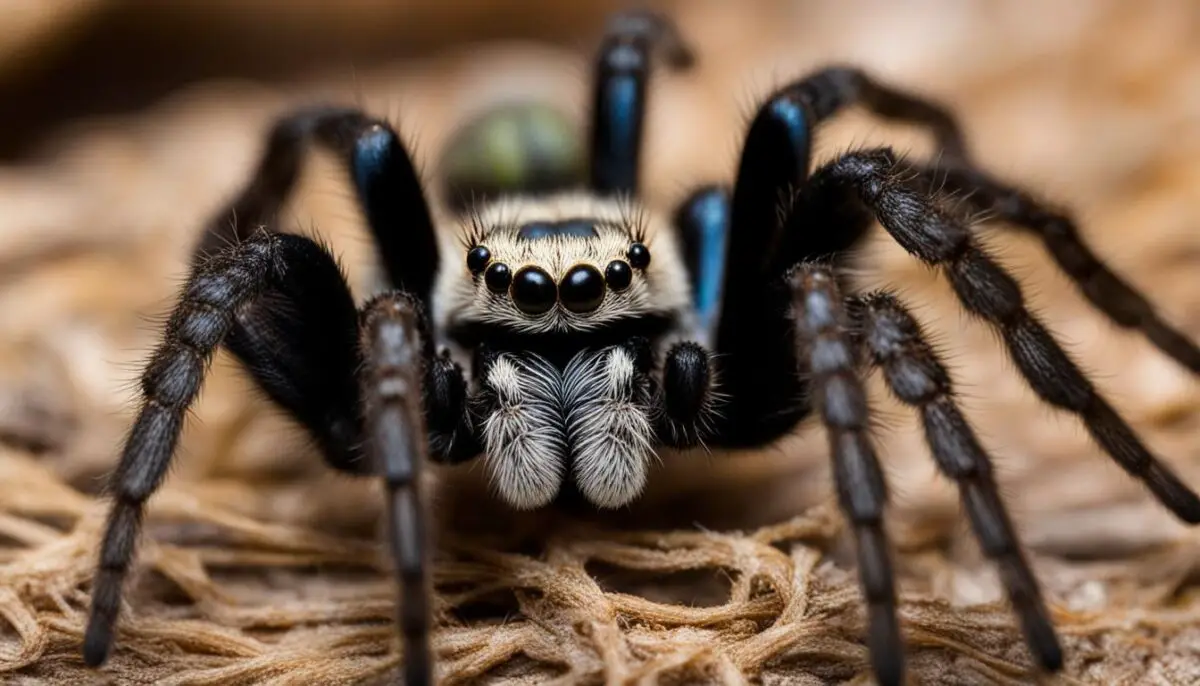
Table: Comparison of Tarantula Silk Properties
| Property | Description |
|---|---|
| Strength | Tarantula silk is incredibly strong, rivaling the strength of steel on a weight-to-weight basis. |
| Flexibility | Tarantula silk is highly flexible, allowing the web to expand and contract without breaking. |
| Lightweight | Tarantula silk is lightweight, enabling easy construction and mobility for the spider. |
| Adhesion | Tarantula silk is highly adhesive, immobilizing prey once it comes into contact with the web. |
The Importance of Spider Webs in the Ecosystem
Spider webs, including those created by tarantulas, play a crucial role in maintaining the balance of ecosystems. These intricate structures act as natural pest control, capturing and consuming insects and other small organisms that could otherwise become pests. By preying on these populations, tarantulas and their webs help to regulate the abundance of certain species, preventing potential outbreaks and imbalances in the ecosystem.
Tarantula webs also provide valuable food sources for other predators, such as birds and lizards. The insects caught in the webs serve as a nutritious meal for these animals, contributing to their survival and overall health. Additionally, tarantulas themselves are an important part of the food chain. They are preyed upon by larger animals, such as snakes and birds of prey, and their webs can act as indicators of a healthy and diverse ecosystem.
Furthermore, the presence of tarantulas and their webs can indicate the overall health of an ecosystem. As sensitive creatures, tarantulas require specific conditions to thrive, including suitable habitats and adequate prey availability. The presence of tarantula webs signals that these conditions are being met, as they are able to successfully establish their webs and capture prey. Thus, the existence of tarantulas and their webs is an indication of a well-functioning and sustainable ecosystem.
| Tarantula Webs in the Ecosystem: | Benefits: |
|---|---|
| Act as natural pest control | Prevents pest outbreaks and imbalances |
| Provide food sources for predators | Contributes to the survival and health of other animals |
| Indicator of a healthy ecosystem | Signals suitable conditions and prey availability |
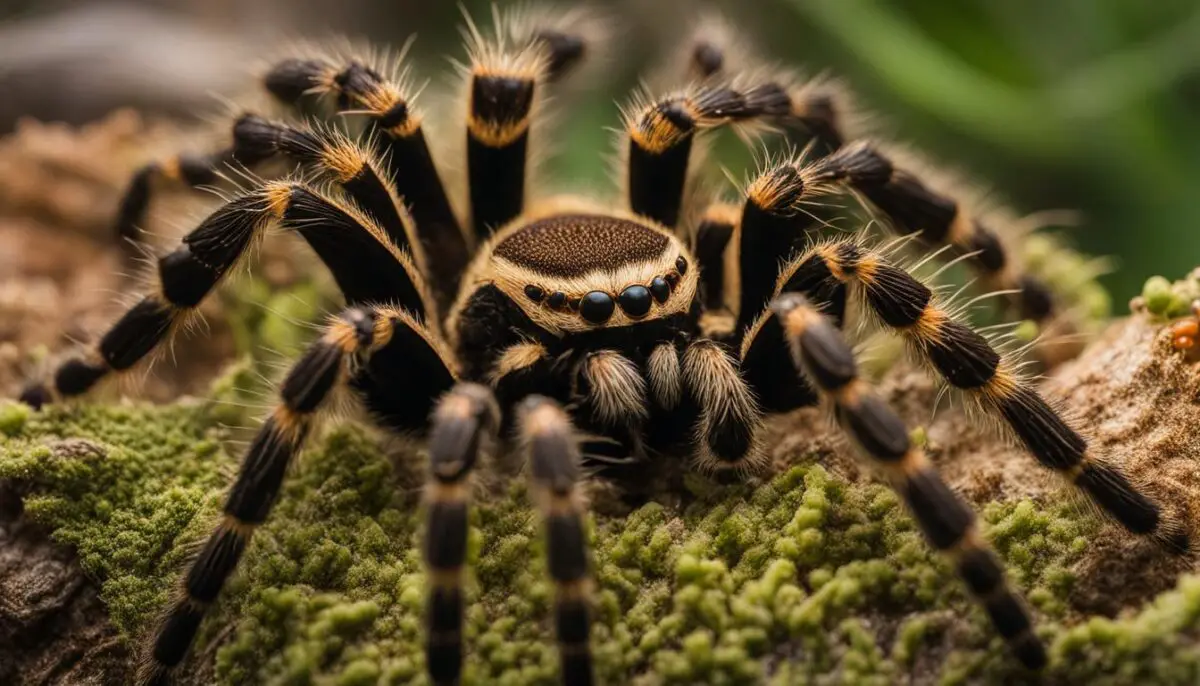
Overall, tarantula webs are important components of the ecosystem, serving as both a means of capturing prey and a valuable food source for other animals. By understanding and appreciating the role of tarantulas and their webs, we can contribute to the conservation and preservation of these remarkable creatures and the ecosystems they inhabit.
How Humans Can Protect Tarantulas and their Webs
Tarantulas and their intricate webs play a vital role in maintaining a healthy ecosystem. As humans, it is our responsibility to protect these fascinating creatures and ensure the preservation of their natural habitats. Here are some ways we can contribute to the conservation of tarantulas and their webs:
- Support habitat conservation: Tarantulas rely on specific habitats for web construction and survival. By supporting organizations and initiatives focused on preserving natural habitats, we can help create safe spaces for tarantulas to thrive.
- Avoid harmful pesticides: Pesticides can have detrimental effects on tarantulas and other beneficial insects. Opt for organic and environmentally friendly pest control methods to minimize their impact on these creatures.
- Promote education and awareness: Spreading knowledge about the importance of tarantulas and their webs is key to their protection. Educate others about their role in the ecosystem and debunk misconceptions to foster a positive attitude towards these spiders.
- Engage in responsible collection: If you choose to keep tarantulas as pets, ensure that they are ethically sourced and legally obtained. Follow proper care guidelines to promote the well-being of the spiders and avoid contributing to illegal wildlife trade.
Remember, tarantulas and their webs are unique and valuable components of our natural world. By taking these steps to protect them, we can contribute to the overall conservation efforts and ensure their continued existence for generations to come.
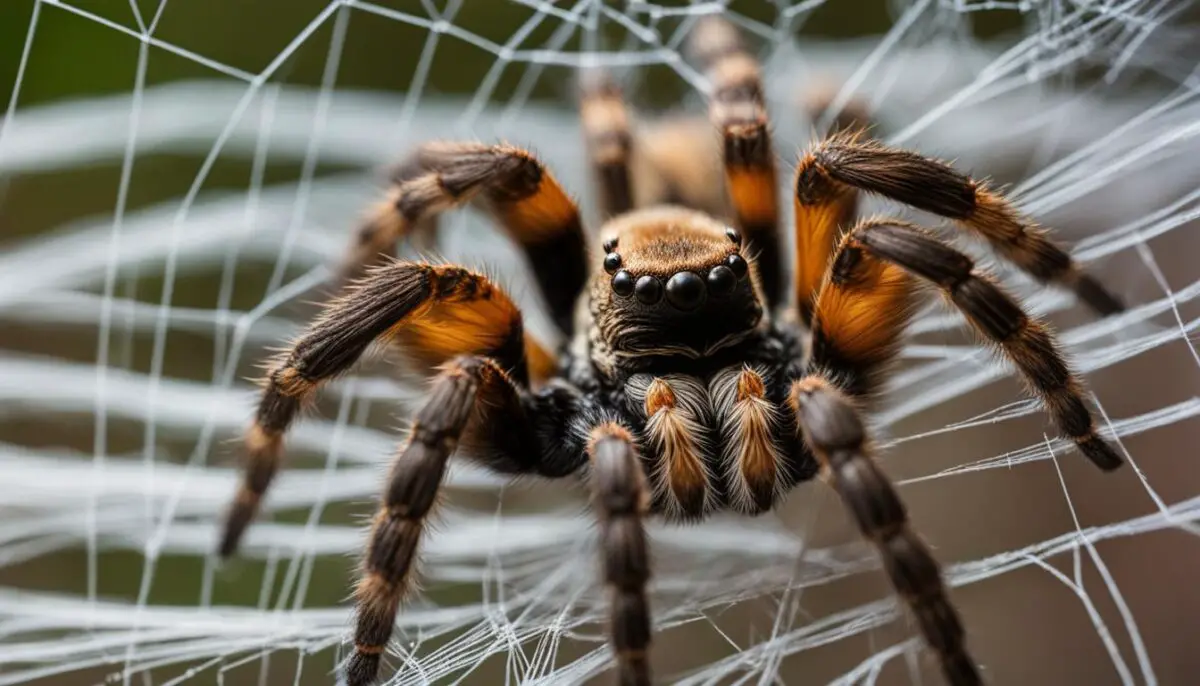
Table: Tarantula Web Characteristics
| Tarantula Species | Web Design | Web Characteristics |
|---|---|---|
| Aphonopelma chalcodes | Simple Sheet Web | Single layer of silk, minimal design |
| Grammostola rosea | Triangular Web | Three-dimensional structure, efficient prey capture |
| Nephila clavipes | Orb Web | Elaborate circular design, sticky capture threads |
| Avicularia avicularia | Tube Web | Cylindrical shape, hidden retreat for ambush hunting |
Conclusion
Tarantulas are truly remarkable creatures with a unique ability to create intricate and effective webs. The process of tarantula web construction involves their spinnerets producing different types of silk, allowing them to spin and weave their webs with precision. These webs are strategically formed and designed to maximize prey capture and protection.
Understanding the science behind tarantula webs is key to appreciating and conserving these fascinating creatures. By preserving their natural habitats and avoiding harmful pesticides, we can help protect tarantulas and their webs. Tarantulas play a vital role in maintaining the balance of ecosystems by acting as natural pest control and providing food sources for other predators.
Research on tarantula webs continues to shed light on their formation, silk properties, and ecological significance. This ongoing research contributes to a better understanding of tarantulas and opens up possibilities for biomimicry and the development of new materials inspired by spider silk. By promoting awareness and appreciation for tarantulas and their webs, we can ensure the preservation of these remarkable creatures for future generations.
FAQ
How do tarantulas make webs?
Tarantulas use a combination of spinning, weaving, and architecting techniques to construct their webs. They start by releasing a fine thread of silk into the air and wait for it to catch on a solid structure, such as a branch or a wall. Once anchored, the tarantula starts to produce more silk and creates a framework for the web. They then fill in the gaps with radial strands and the capture threads, which are sticky silk lines that trap prey.
What are tarantula spinnerets?
Tarantulas have spinnerets, which are located at the end of their abdomen. These spinnerets are responsible for silk production. Tarantulas have multiple pairs of spinnerets, each producing a different type of silk. The silk produced by tarantulas is a complex protein-based material that is incredibly strong and elastic. The spinnerets play a crucial role in the formation and construction of tarantula webs.
What are the characteristics and designs of tarantula webs?
Tarantula webs have distinct characteristics and designs that are specific to each species. These characteristics and designs are influenced by the tarantula’s habitat, hunting strategies, and prey preferences. Some tarantulas create elaborate, intricate webs with multiple layers and zigzag patterns, while others build simpler webs with a single layer of silk. The design of the web also plays a role in maximizing the tarantula’s chances of capturing prey effectively.
How do tarantulas select the location for their webs?
Tarantulas have a strategic approach to web formation. They carefully select the location for their web, taking into consideration factors such as prey availability, shelter, and camouflage. Tarantulas also adapt their web formation techniques based on environmental conditions, such as wind and humidity. They continually assess and update their webs to ensure optimal prey capture and protection.
What is spider ballooning?
In addition to building webs, tarantulas have a unique method of traveling called ballooning. Ballooning involves the spider spinning silk threads and using the wind to transport them to new locations. This behavior is especially common among baby tarantulas, known as spiderlings, as it allows them to disperse and find new habitats without competing with their siblings. Ballooning is an adaptive strategy that helps tarantulas colonize new areas and maintain their populations.
What are the properties of spider silk?
Spider silk is a remarkable material with exceptional properties. It is incredibly strong, flexible, and lightweight. Tarantulas produce silk that is thick and fibrous, allowing it to capture prey effectively. The composition of tarantula silk includes proteins and other organic compounds. The unique structure of spider silk gives it its remarkable properties, making it an ideal material for web construction.
What is the importance of spider webs in the ecosystem?
Spider webs, including those created by tarantulas, play a crucial role in maintaining the balance of ecosystems. They act as natural pest control by capturing and consuming insects and other small organisms. Tarantula webs provide valuable food sources for other predators, such as birds and lizards. The presence of tarantulas and their webs indicates a healthy and diverse ecosystem.
How can humans protect tarantulas and their webs?
It is essential for humans to understand and respect the importance of tarantulas and their webs in the natural environment. To protect tarantulas, habitat conservation is crucial. Preserving their natural habitats ensures that they have suitable areas to build their webs and thrive. It is also important to avoid using harmful pesticides that can harm tarantulas and other beneficial insects. By promoting awareness and appreciation for these fascinating creatures, we can contribute to their conservation.
What are some common myths and misconceptions about tarantulas?
Tarantulas have often been misunderstood and portrayed negatively in popular culture. Many myths and misconceptions surround these spiders, leading to fear and misinformation. It is essential to debunk these myths and educate the public about the true nature of tarantulas. They are beneficial creatures that play a vital role in maintaining the balance of ecosystems.
What is the future of tarantula web research?
Research on tarantula webs and their construction process is ongoing. Scientists continue to study the intricate details of tarantula web formation, silk properties, and the role of webs in the ecosystem. This research contributes to a better understanding of tarantulas and their importance in the natural world. It also opens up possibilities for biomimicry and the development of new materials inspired by spider silk.
